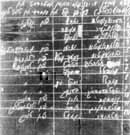
|
|
|

|

|

|

|
|
Click on an image to see a larger, more detailed picture.
|
|
|
|
|
| 1941: Mass Murder |

|
pg. 287 |

|
|
|
|
| |
 Many perpetrators of the Holocaust prided themselves on their record-keeping, even when, as on this slate of prisoners' names photographed at the Chelmno death camp, the notation was done quickly and impermanently. Such records were maintained to keep track of daily work details, new arrivals, deaths, and other camp data. Not surprisingly, inaccuracies were common, even on printed material.
Many perpetrators of the Holocaust prided themselves on their record-keeping, even when, as on this slate of prisoners' names photographed at the Chelmno death camp, the notation was done quickly and impermanently. Such records were maintained to keep track of daily work details, new arrivals, deaths, and other camp data. Not surprisingly, inaccuracies were common, even on printed material.
Photo: Main Commission for the Investigation of Nazi War Crimes / United States Holocaust Memorial Museum Photo Archive
|
 SS General Arthur Greiser co-founded the Stahlhelm, a nationalist German veterans organization, after the First World War. An SS administrator in Poland following the outbreak of the Second World War, he deported thousands of Jewish and Christian Poles to create living space for Germans in Eastern Europe. A brutal Nazi, he was captured after the war, tried, and--after being paraded around Poznan in a cage--hanged in front of his former palace on June 20, 1946.
SS General Arthur Greiser co-founded the Stahlhelm, a nationalist German veterans organization, after the First World War. An SS administrator in Poland following the outbreak of the Second World War, he deported thousands of Jewish and Christian Poles to create living space for Germans in Eastern Europe. A brutal Nazi, he was captured after the war, tried, and--after being paraded around Poznan in a cage--hanged in front of his former palace on June 20, 1946.
Photo: United States Holocaust Memorial Museum Photo Archive
|
 Chelmno
Chelmno
"It's hard to recognize," said Shimon Srebnik, "but it was here. They burned people here." Srebnik, 47, had returned to Chelmno, a place he first saw in the summer of 1944 when he was sent there from the Lódz Ghetto at the age of 13. The SS assigned Srebnik to a work detail. Shot and left for dead by the fleeing Nazis as Soviet troops approached in January 1945, Srebnik was one of the very few Jews who survived the killing center. Situated in Poland, about 50 miles west of Lódz, Chelmno was the first Nazi extermination camp. More than 150,000 Jews and about 5000 Gypsies were murdered there. Chelmno's victims perished in special mobile gas vans that piped deadly engine exhaust fumes into the trucks' hermetically sealed interior compartments. Chelmno operated from December 1941 to March 1943. It reopened in the spring of 1944 during the liquidation of the Lódz Ghetto. That September the Nazis tried to obliterate the evidence of mass murder by exhuming the mass graves and burning the remains. "A lot of people were burned here," Srebnik recalled. "Yes, this is the place. No one ever left here again."
Photo: Yad Vashem
|
|

|

|

|

|
 December 9, 1941: China declares war on Germany and Japan.
December 9, 1941: China declares war on Germany and Japan.
|
 December 11, 1941: Germany and Italy declare war on the United States. Germany, Italy, and Japan agree that none will pursue a separate peace.
December 11, 1941: Germany and Italy declare war on the United States. Germany, Italy, and Japan agree that none will pursue a separate peace.
|
 December 11, 1941: The United States declares war on Germany and Italy, which provides hope to Europe's Jews. The U.S. will concentrate nearly 90 percent of its military resources within the European Theater, to defeat the Nazis.
December 11, 1941: The United States declares war on Germany and Italy, which provides hope to Europe's Jews. The U.S. will concentrate nearly 90 percent of its military resources within the European Theater, to defeat the Nazis.
|
 December 11, 1941: A Jewish ghetto is established at Lutsk, Ukraine.
December 11, 1941: A Jewish ghetto is established at Lutsk, Ukraine.
|
 December 11-13, 1941: More than 14,000 Jews are murdered by Einsatzkommandos in Simferopol, Ukraine.
December 11-13, 1941: More than 14,000 Jews are murdered by Einsatzkommandos in Simferopol, Ukraine.
|
 December 13, 1941: The last six Jews living in Warendorf, Germany, are deported to Riga, Latvia, and killed.
December 13, 1941: The last six Jews living in Warendorf, Germany, are deported to Riga, Latvia, and killed.
|
 December 14, 1941: A Jewish ghetto at Kharkov, Ukraine, is established.
December 14, 1941: A Jewish ghetto at Kharkov, Ukraine, is established.
|
 December 14, 1941: In the Warsaw Ghetto, a German policeman opens fire on a Jewish funeral procession, killing two mourners and wounding five other people.
December 14, 1941: In the Warsaw Ghetto, a German policeman opens fire on a Jewish funeral procession, killing two mourners and wounding five other people.
|
|
|
|
|
| 1941: Mass Murder |

|
pg. 287 |

|
|
The Holocaust Chronicle
© 2009 Publications International, Ltd.
|
|
